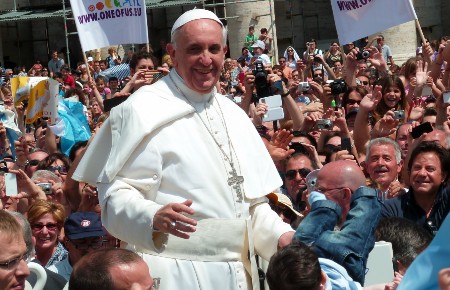We ask you, humbly: don't scroll away.
Hi readers, it seems you use Catholic Online a lot; that's great! It's a little awkward to ask, but we need your help. If you have already donated, we sincerely thank you. We're not salespeople, but we depend on donations averaging $14.76 and fewer than 1% of readers give. If you donate just $5.00, the price of your coffee, Catholic Online School could keep thriving. Thank you.Help Now >
Diocese of Bertinoro
FREE Catholic Classes
Bertinoro, anciently called Forum Truentinorum, and, at the time of the Gothic war, Petra Honorii, whence the present name, is a small city in Romagna, province of Forli, Italy. According to legend, about the year 303 St. Illuminata, a virgin of Ravenna, took refuge here, but did not escape martyrdom. Up to 1360 Bertinoro was subject to the Bishop of Forlimpopoli; in that year, however, Cardinal Albornoz being commander of the troops of Pope Gregory IX, the latter city was destroyed, and the episcopal seat was transferred to Bertinoro. A word will first be said of Forlimpopoli.
Forlimpopoli was founded in 173 B.C. by the Consul M. Popilius Laenas. The first bishop is supposed to have been St. Rufillus, appointed by Pope St. Sylvester, and he is supposed to have transformed a temple of Isis into a church. At all events St. Rufillus is the patron of the city, and the church in which his body is preserved is said to have been an ancient temple of Hercules. In 500 Asellus, Bishop of Forlimpopoli, was present at the Roman synod that passed on the election of Pope Simmaeus, and in 649 Bishop Stephen attended the Roman council concerning the Monothelites. This city had much to suffer from the Lombards, and in 665 or 670, while the people were assembled in the cathedral for the ceremonies of Holy Saturday, it was suddenly attacked by King Grimoald, who pillaged it and butchered numbers of the people and clergy (Paul Diac., Hist. Lang., V, x). By the famous donation of Pepin, Forlimpopoli with the other cities of the exarchate and the Pentapolis was made a part of the patrimony of St. Peter. In 1073 during the episcopate of Pietro, St. Peter Damian went to Forlimpopoli to reform ecclesiastical disciplines, and on this occasion is thought to have delivered a sermon on St. Rufillus, which Vecchiazzani, an historian of this city, claims to have discovered at Rimini in the Library of St. Jerome . But this is very doubtful. Among the successive bishops, Ubertello (1214) and Taddeo (1285) were noted for their beneficence and their efforts for the preservation of peace. During the fourteenth century Romagna was at the mercy of petty tyrants and Forlimpopoli was ruled by the Ordelaffi of Forli. Innocent VI first tried censures as a means of enforcing his commands as sovereign, and sent Cardinal Albornoz to Forlimpopoli (1355). Francesco II, of the Ordelaffi family, however, when the cardinal had left, burned the statue of the pope in the public square, and was guilty of great cruelty towards the clergy.
In 1360 Albornoz took the city by force, obliged the inhabitants to abandon it, and razed it to the ground. The episcopal see was then transferred to Bertinoro, and the bishop, Roberto dei Resinelli, an Augustinian, took with him the relics of St. Rufillus. Forlimpopoli was gradually rebuilt, and Leo XII restored it to the rank of a city. The bishop, however, remained at Bertinoro. In 1377 Roberto was succeeded by Bishop Teobaldo, who received from Urban VI the civil authority over Bertinoro and Cesena, and by virtue of his authority fought against the bodies of mercenaries recruited by the Antipope Clement VII, by whom he was made prisoner. Bishop Ventura degli Abati was highly praised by Martin V for his learning and piety. Tommaso Caselli, a Dominican (1544), was an able theologian ; Gianandrea Caligari (1580), formerly nuncio to Poland, restored the Cathedral of Santa Caterina. Giovanni della Robbia (1624), a Dominican, established at Forlimpopoli the Accademia degli Infiammati. In 1803 Pope Pius VII was obliged to suppress the Diocese of Bertinoro which, however, was re-established in 1817. From 1824 to 1859 it was united to the Diocese of Sarsina . In the Diocese of Bertinoro is situated the celebrated church of Polenta, in Romanesque style, which inspired one of the most beautiful odes of Carducci.
The diocese contains 63 parishes, 93 churches, chapels, and oratories, 92 secular priests, 78 regulars, 32 seminary students, 5 lay brothers, 90 members of female religious orders, 1 school for boys, and 5 for girls, and a population of 32,500.









 Daily Readings for Friday, April 26, 2024
Daily Readings for Friday, April 26, 2024 St. Cletus: Saint of the Day for Friday, April 26, 2024
St. Cletus: Saint of the Day for Friday, April 26, 2024 Prayer before the Closing of the Day: Prayer of the Day for Friday, April 26, 2024
Prayer before the Closing of the Day: Prayer of the Day for Friday, April 26, 2024

